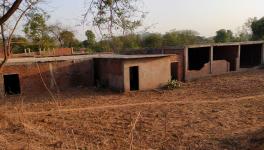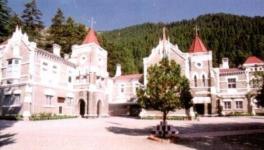Explainer: The How and Why of Proposed Evictions in Haldwani’s ‘Railway Land’
Haldwani (Uttarakhand)/New Delhi: More than 50,000 people, mostly Muslims, have been put at risk of being made homeless in the biting cold — thanks to the Uttrakhand High Court order of clearing “illegal construction on railway land”. A division bench of justices Sharad Sharma and RC Khulbe on December 21, 2022 directed demolition of construction over “encroached railway land” near Haldwani Railway Station at Banbhoolpura on a one week’s notice.
Following the order, eviction notices have been issued through local newspapers to 4,365 households spread over 78 acres. The occupants have been directed to vacate the area till January 7, failing which they would be removed by force.
Bulldozers are set to roll at Ghafur Nagar, Dholak Basti and adjoining areas, such as Indira Nagar, Nayi Basti and Line No. 17, 18, 19 and 20. All these localities are densely populated, and people have been residing here for decades.
The residents, mostly living there for decades, are raising their voice against the order, but in vain. The decision has also been challenged in the Supreme Court, which has listed the matter for hearing on January 5.
HOW IT ALL STARTED
On November 9, 2000 Uttarakhand was carved out of Uttar Pradesh and the High Court of Uttarakhand at Nainital was established.
A member of the Uttarakhand High Court Bar Association, who had come here from Allahabad (now Prayagraj), demanded in 2007 that a train service be launched between Kathgodam and Allahabad for people from Uttar Pradesh.
This was turned down on the pretext that the Haldwani Railway Station had no more area to run a new train. The issue of alleged encroachment was first raised then. It was alleged that there was an encroachment on 29 acres of Railway land near Haldwani station.
The Railway, in an affidavit filed in the same year, informed the Uttarakhand High Court that it had got 10 acres of the 29 acres cleared from encroachers and appealed to the court to pass an order, directing state authorities to help it get back the rest 19 acres. The issue subsided and no further demolition was carried out.
The issue resurfaced in 2014 when one Ravi Shankar Joshi filed a writ petition in the form of a Public Interest Litigation (PIL) in the High Court, praying it to order an investigation into the collapse of a bridge — which was constructed in 2003 on local Gola river with an expenditure of Rs 9.40 crore.
The bridge had collapsed within three-four years of its construction. After hearing the petitioner, the court appointed HM Bhatia as commissioner by its order dated September 1, 2014 to submit a report on the bridge collapse.
The Advocate Commissioner visited the area and submitted a report on June 26, 2015, alleging that “encroachers” residing close to the railway track near Haldwani station indulged in illegal mining that caused the bridge collapse.
Following the commissioners’ report, the High Court summoned the Railway — which once again reiterated that its 29 acres have been encroached upon. The court passed an interim order on November 9, 2016, directing the authorities to remove the alleged encroachment from Railway property.
The Uttarakhand government subsequently appealed to the court, seeking it to review its interim order. The state said removal of the “encroachers” could not be undertaken as there was no demarcation of Railway property.
The petition also referred to a few sale deeds. The state also filed a counter affidavit, asserting that the land belonged to the Revenue Department. On January 10, 2017, the High Court once again directed the state government to ensure removal of the alleged encroachment.
Aggrieved by the order, Jan Sahyog Sewa Samiti, representing private parties (the aggrieved occupants of the “encroached” land) approached the Supreme Court along with the state government and informed it that the proceedings before the High Court, which were initiated in the nature of a PIL, did not even entail a prayer for the removal of “encroachments” from the alleged Railway land.
It was submitted that the pleadings in the High Court also never expressed unauthorised occupants. The apex court was told that it is not even clear whether the land in question belongs to the Railways. It was also informed there is no demarcation of the 29 acres, as alleged by the petitioner in the PIL.
The petitioners further said the entire area contained permanent structures — including schools, colleges, health centres, houses, commercial sites and religious place, such as mosques and temples — and the occupation on it has been continuing from a date before the country’s Independence.
The possession of the petitioners, the court was told, has been for several decades and at least, 50,000 people would be affected by the High Court order.
The petitioners also brought the court’s attention to the documents, indicating that they were in possession of the land based on government leases executed in their favour.
In some other cases, they claimed possession on account of an allotment having been favoured with the same as the highest bidders at an auction. They, therefore, claimed that their possession is legitimate, authorised, and legal.
It was mentioned that none of the eviction notices issued to the petitioners under the Public Premises (Eviction of Unauthorised Occupants) Act, 1971 or PP Act were addressed to them individually as mandated by the legislation.
The notices, the petitioners said, were addressed to “all unauthorized occupants of Railways land, adjoining to Haldwani Railway Station from Km. 78/0 to 83/0 Haldwani”. Therefore, the contention that none of the petitioners were individually served notices before the eviction order of the High Court came against them.
Though the petitioners sought an appellate remedy against the eviction orders passed under the PP Act, it was frustrated by the impugned High Court order.
Some of the petitioners had approached the High Court to assail the eviction notices, but their matters were listed before a single bench that in any case was bound by the directions issued by the division bench.
Considering the submissions, the apex court on January 18, 2017 said the aggrieved petitioners must be heard by the High Court. It directed the affected parties to move the High Court and file individual applications, seeking recall or modification of its order.
It directed the matter must be heard by a division bench. The top court said the High Court would pass any order only after the petitioners were afforded an opportunity for hearing and their individual contention has been taken care of.
Further, the High Court was directed to dispose of all such applications within a period of three months, with effect from February 13, 2017. Accordingly, the directions issued by the High Court stayed for a period of three months.
The Supreme Court also clarified that the appellate proceedings initiated by the occupants, pending before the District Judge, Nainital, shall be dealt with “uninfluenced” by the observations recorded by the High Court.
Following the top court’s orders, the High Court directed the Railway to appoint an Estate Officer to ascertain the legal title of the land in question, issue notices to every individual occupant and hear their objections to dispose them of on merits, as mandated by Section 4 of the PP Act.
The Estate Officer, allegedly without referring to any source, concluded that he was of the opinion that the land belonged to the Railways and the occupants were “illegal encroachers” who needed to be removed.
Accordingly, fresh eviction notices were served to people, occupying the 78 acres spread over Banbhulpura’s Indira Nagar, Nayi Basti, and Line No. 17, 18, 19, and 20.
WHAT IS THE CATCH?
The land in dispute was 29 acres, but the notices were issued to people residing on 78 acres. Nowhere in the official records is the land in question measuring 78 acres. Then how did this happen? The Railways claims it owns 29 acres, but they demarcated and installed pillars on 78 acres in 2016.
Upon receiving the notices, the residents filed their objections in the office of the Estate Officer at Izzat Nagar in Bareilly. But no hearing took place because of the outbreak of the COVID-19 pandemic. No further public information was issued, informing people about the commencement of hearing of the objections that began after COVID-19 restrictions were over.
Those who turned up for hearing were allegedly not heard.
All the objections were rejected ex-parte, as residence in absence of any information with regard to the re-hearing failed to turn up. The Railway said no “encroacher” could produce any legal document to claim the said land.
Following the ex-parte orders, appeals were filed in the court of the District Judge, Nainital, under Section 9 of the PP Act, challenging the Estate Officer’s decisions. Over 1,700 appeals are still pending in the court, and the applicants are being heard.
In the meantime, the Railways wrote to the district magistrate, informing him that all objections have been decided ex-parte and they need police assistance for demarcation and eviction of “illegal occupants”. It prompted a fresh hearing of the PIL in the High Court.
“Without waiting for all the appeals to be disposed of by the district court, the High Court in violation of the PP Act issued fresh eviction order on December 20, 2022, and gave the administration one-week time to execute its order,” alleged Advocate Mohammad Yusuf, who is representing many petitioners in the district court, while talking to NewsClick.
WHO OWNS THE LAND?
The state government, through an affidavit in 2016, had challenged the Railway’s claim. It had informed the court that had been residing on the land in question for years. Several had purchased the land, and the rest had got it on lease from the government. The Railways had no ownership of the property, said the affidavit. But later, it backtracked.
A majority of people in Banbhulpoora’s Nai Basti have patta (land lease) of the nazul’s property. There are people in Line No. 17 area who had bought enemy property through auction-sale certificate (evidence of title) issued by the Union Ministry of Rehabilitation in 1947. Local authorities, too, a allotted land deeds of such properties.
When the then Congress government brought a new nazul policy in 2009, prohibiting allotments of such lands against pattas, these were converted into freehold land. Many occupants have such sale deeds.
“The high court says that the land deeds have expired and have not been renewed. We say who had issued the pattas (leases) — the state government? Then from where has the Railways come into picture? The Railways has only shown a map in support of its claim,” said advocate Yusuf.
So, people in Haldwani have pattas, bainama and freehold land. They pay house tax, water tax and scavenging tax, etc. to the government. “If the government takes house tax from an occupant of a land, it certifies that he or she is the legal custodian of the property and not an encroacher,” he added.
But the Railway, as per the records, except a map, has not so far presented any credible evidence to prove its title over the land. It has also accepted in an RTI reply that it does not have any other document apart from the map in support of its claim on the land in question.
Responding to a query filed under the Right to Information in 2017, the Municipal Corporation said the primary health centre situated in old ward number 14 is in its records. It also revealed that except the freehold, the entire land in the ward is registered in the civic body’s records as the property of the state’s revenue department.
The government has spent thousands of crores to develop the area and provide people with basic facilities like water, roads, electricity, education, etc.
The area has two government colleges, three schools and religious places, apart from commercial establishments.
THE POLITICS
Haldwani is the only Assembly seat in Nainital district that the ruling Bharatiya Janata Party (BJP) lost. If Muslims are evicted from the area, allege locals, the saffron party would be able to comfortably win the constituency. “And therefore, we are being targeted,” a Muslim community member alleged.
UNANSWERED QUESTIONS
The entire sequence of events raises two crucial questions:
(a) In 2007, the Railways claimed it had 29 acres. In 2022, this mysteriously increased to 78 acres. How and why?
(b) In 2016, the state government challenged the Railways’ claims but in 2022, it said it has no say on the land. Why?
Get the latest reports & analysis with people's perspective on Protests, movements & deep analytical videos, discussions of the current affairs in your Telegram app. Subscribe to NewsClick's Telegram channel & get Real-Time updates on stories, as they get published on our website.
























